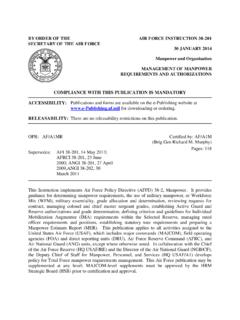Transcription of BY ORDER OF THE SECRETARY AIR FORCE INSTRUCTION 38 …
1 BY ORDER OF THE SECRETARY OF THE AIR FORCE AIR FORCE INSTRUCTION 38-204 21 APRIL 2015 manpower and Organization PROGRAMMING USAF manpower COMPLIANCE WITH THIS PUBLICATION IS MANDATORY ACCESSIBILITY: Publications and forms are available for downloading or ordering on the e-Publishing website at (will convert to on AF Link). RELEASABILITY: There are no releasability restrictions on this publication. OPR: AF/A1MP Supersedes: AFI 38-204, 1 August 1999 Certified by: AF/A1 (Mr. Robert Corsi) Pages: 49 This INSTRUCTION implements Air FORCE Policy Directive (AFPD) 38-2, manpower . It explains how to program and allocate Air FORCE Active, Civilian, and Air Reserve Component (ANG and USAFR) manpower resources. In addition, it explains the manpower Programming and Execution System (MPES) and how it is used to develop various manpower reports for multiple stakeholders and conduct manpower program evaluation.
2 Except where otherwise noted, this publication applies to all activities assigned to the United States Air FORCE (USAF), which include Major Commands (MAJCOM), Field Operating Agencies (FOA), Direct Reporting Units (DRU), Air FORCE Reserve Command (AFRC), and Air National Guard (ANG) units. In collaboration with the Chief of Air FORCE Reserve (AF/RE) and the Director of the Air National Guard (NGB/CF), the Deputy Chief of Staff for manpower , Personnel and Services (AF/A1) develops policy for USAF manpower programming. This Air FORCE publication may be supplemented at any level; however, all supplements must be approved by the Human Resource Management Strategic Board (HSB) prior to certification and approval. Refer recommended changes and questions regarding this publication to Headquarters USAF manpower , Organization and Resources, Program Development Division (AF/A1MP) using the AF Form 847, Recommendation for Change of Publication; route AF Form 847 from the field through channels to AF/A1MP, 1040 Air FORCE Pentagon Suite 5B349, Washington, DC 20330-1040 or e-mail: USAF Pentagon AF-A1 Mailbox AF-A1MP The authorities to waive wing, unit, or FOA/DRU level requirements in this publication are identified with a Tier ( T-0, T-1, T-2, and T-3 ) number following the compliance statement.
3 See AFI 33-360, Publications and Forms Management, for a description of the authorities associated with the Tier numbers. Submit requests for waivers through the chain of command to the appropriate Tier 2 AFI38-204 21 APRIL 2015 waiver approval authority, or alternately, to the Publication OPR for non-tiered compliance items. Ensure that all records created as a result of processes prescribed in this publication are maintained in accordance with Air FORCE Manual (AFMAN) 33-363, Management of Records, and disposed of in accordance with Air FORCE Records Disposition Schedule (RDS) in the Air FORCE Information Management System (AFRIMS). The use of a name or mark of any specific manufacturer, commercial product, commodity, or service in this publication does not imply endorsement by the Air FORCE .
4 SUMMARY OF CHANGES This publication has been substantially revised and must be completely reviewed. Major changes include expansion of manpower programming information contained in 1 Aug 1999 version of AFI 38-204, realignment of some information to AFI 38-201, Management of manpower Requirements and Authorizations, transfer of information formerly contained in the rescinded 1 Mar 1995 version AFI 38-202, Air FORCE Management Headquarters and Headquarters Support Activities, new organizational references, addition of base support factors, identification of manpower data system changes, and Tier Waiver Authorities as outlined in AFI 33-363, Publications and Forms Management, paragraph Chapter 1 GENERAL INFORMATION 5 Overview.
5 5 Guiding Principles.. 5 Events.. 5 Roles and Responsibilities.. 6 Chapter 2 DEFINING AND MANAGING AIR FORCE END STRENGTH 8 manpower Resource Accountability.. 8 General Guidance.. 8 Chapter 3 PROGRAMMING TOOLS 10 Estimating manpower Requirements.. 10 Weapon System Zero Base (ZB) Procedures.. 10 Base Support Tail (BST) Factors.. 12 Management Headquarters (MHQ) Factors.. 12 Individuals Account manpower Programming Tools.. 13 Chapter 4 ADJUSTING END STRENGTH 14 AFCS Change Control Number (CCN).. 14 manpower Zero Balance Transfer (ZBT).. 14 Out of Cycle End Strength Changes.. 15 AFI38-204 21 APRIL 2015 3 Chapter 5 ADJUSTING END STRENGTH- SPECIAL CONSIDERATIONS 17 Overview.. 17 Overseas Ceilings/Floors.. 17 The Executive Agent Roles and Responsibilities.
6 17 Major DoD Headquarters Activities.. 18 Joint manpower .. 18 Special Access Programs (SAP).. 18 Defense Health Programs.. 18 Special Operations Forces (SOF).. 18 Intelligence.. 18 Foreign Military Sales (FMS).. 18 Chapter 6 manpower ALLOCATION AND UMD EXECUTION 19 Overview.. 19 General Guidance.. 19 Roles and Responsibilities .. 19 MAJCOM UMD Management.. 20 Chapter 7 manpower DATA SYSTEMS, REPORTING, AND PROGRAM EVALUATION 21 Overview.. 21 AF/A1MP Roles and Responsibilities - Budget Development and OSD/Congressional Reporting.. 21 AF/A1MP Roles and Responsibilities MAJCOM and Equivalent manpower Programming.. 22 AF/A1MP Roles and Responsibilities - Joint manpower Programming.. 22 AF/A1MP Roles and Responsibilities manpower Program Evaluation.
7 22 Chapter 8 INDIVIDUALS ACCOUNT - STUDENTS, TRANSIENTS AND PERSONNEL HOLDEES (STP) PROGRAM 24 8. 1. Overview.. 24 Roles and Responsibilities.. 24 STP (Individuals) Account Categories.. 25 Attachment 1 GLOSSARY OF REFERENCES AND SUPPORTING INFORMATION 27 Attachment 2 PPBE SYSTEMS AND TOOLS 32 Attachment 3 manpower PROGRAMMING AND EXECUTION SYSTEM (MPES) 34 4 AFI38-204 21 APRIL 2015 Attachment 4 ATTRIBUTES OF A PROGRAM ELEMENT 36 Attachment 5 AIR FORCE manpower RESOURCE IDENTIFICATION CODES 39 Attachment 6 WEAPON SYSTEM ZERO BASE TEMPLATE 41 Attachment 7 BASE SUPPORT TAIL (BST) FACTORS 46 Attachment 8 OVER/UNDER EXECUTION REQUEST EXAMPLE 48 Attachment 9 MANAGEMENT HEADQUARTERS FACTORS 49 AFI38-204 21 APRIL 2015 5 Chapter 1 GENERAL INFORMATION Overview.
8 Air FORCE manpower is a critical resource. manpower must be properly identified and resources allocated to ensure the Air FORCE has the capability to achieve its peacetime and wartime missions. To support national security objectives, Air FORCE units must successfully accomplish missions using the optimal level of manpower that includes Active, Civilian, Air Reserve Component (ANG and USAFR) manpower resources and work that can be completed by private-sector contractor support. The programming process is how the Air FORCE ensures commanders have the manpower resources to accomplish their assigned missions. Guiding Principles. manpower guiding principles for requirements and programming are highlighted in DoDD , Guidance for manpower Management, DoD Policies and Procedures for Workforce Mix, AFPD 38-2 manpower , AFI 38-201, Management of manpower Requirements and Authorizations, and provides guidance which must be considered when evaluating and executing programming decisions and activities.
9 manpower is a constrained resource that comprises a large portion of the Air FORCE Budget. All missions and programs compete for limited authorized military and civilian end-strength, established grade distributions, and must comply with other guidelines as directed by Congress. manpower resources must be programmed and allocated in a manner that contributes to the accomplishment of Air FORCE missions in priority ORDER , and commensurate with available resources. Changes to programs, missions, capabilities and/or functions will dictate changes to manpower resources. Private-sector contract support programming is not addressed in this AFI and should be managed in accordance with the FAR and applicable SAF/AQ guidance.
10 manpower must be programmed in accordance with validated manpower requirements, and within fiscal limits and acceptable risk identified in Defense Planning Guidance (DPG). Military manpower and appropriated civilian resources will be allocated to approved programs by Program Element (PE) consistent with budget submissions and Congressional direction. manpower will not exceed approved levels, violate guidelines established by Congress, or violate other statutory limitations. The civilian workforce shall be managed on the basis of workload and fiscal year funding except where imposed by Congress. See Chapter 2 for additional information. Events. manpower is programmed in conjunction with the Air FORCE Planning, Programming, Budgeting and Execution (PPBE) process as outlined in AFPD 16-5 Planning, Programming, Budgeting and Execution System and AFI 16-501 Control and Documentation of Air FORCE Programs.











